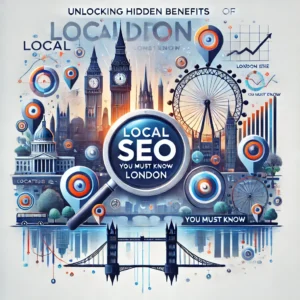
What Is Landing Page In SEO? How to Build High-Converting Pages That Rank
Table of Contents
⚡ New here? Check out our most demanding Landing Page Design & SEO Services Now!
Do you want to get conversions without spending a single penny? You can accomplish this by creating SEO-friendly landing pages.
There are a lot of concepts and terms that can seem somewhat overwhelming, particularly when you’re starting out Search Engine Optimization (SEO). One of these terms is “landing webpage.” However, don’t worry! In this article, we’ll help you understand the concept of a “landing page” in SEO and simplify it into simple, understandable terms. In the end, you’ll know what is a landing page, why it is important to SEO, and how you can utilize it to improve your online visibility and conversion.
What are Landing Pages?
A “landing” page, as defined in SEO terms, is a particular web page that a person “lands” on when they click an ad from the search engine result page (SERP) or another source, like an advertisement or a social media post. Landing pages aim to provide pertinent information and to encourage users to take specific actions, which is often referred to as a “conversion.” This could be “sign up for an email newsletter,” or making a purchase, or using an inquiry form.
What Is Landing Page In SEO? Main Elements of a Landing Page
SEO landing pages are designed to rank well in search engine results pages (SERPs). This means that they are more likely to be seen by potential customers who are searching for keywords related to your product or service. SEO landing page optimization must include some features such as SEO-friendly content, relevant keywords, and a clear call to action. Additionally, they need to be optimized for mobile devices.
The role of landing Pages in SEO
⚡ New here? Check out our most demanding Landing Page Design & SEO Services Now!
The landing pages play an important function in SEO for various reasons:
- Relevance: Search engines strive to provide users with the best results. Optimized landing pages aid search engines in determining the importance of content to specific queries and increase the chance of appearing higher in SERP.
- User Experience: The landing pages are created to be user-friendly. A great user experience can result in lower bounce rates, more time spent on a page, and, ultimately, a higher ranking on search engines.
- Targeted Traffic: By creating landing pages for particular keywords or areas, you can attract highly targeted traffic. That means the people who visit the landing pages are likely to be interested in your products and, in turn, convert.
- Conversion Tracking: Landing Pages permit you to monitor the results of your SEO efforts by observing the number of conversions. This information helps you determine what’s working and which areas require improvements.
- Content Organization: Landing pages can help you arrange your website’s content, which makes it simpler for users, as well as crawlers, to discover what they’re searching for.
Different Types Of Landing Pages
The landing pages are available in a variety of kinds, each with different purposes. Here are the most common types of landing pages used in SEO:
- Lead Generation Landing Page: They’re designed to collect visitor data, including email addresses, via form or registration buttons. They are typically employed for creating email lists as well as cultivating leads.
- Click-Through Pages: Click-through pages can be designed to help you sell an item or service. They offer information and benefits in order to convince people to visit a different page, for example, an information page or a sales page.
- Product or Service Landing Pages: These pages are designed to showcase a specific item or service. They offer complete information, photos, and pricing information to assist potential buyers in making an informed decision.
- Splash Pages: Splash pages are typically employed for announcements and promotions or to gather the information needed to verify age. They’re typically one page with an explicit, precise goal.
- Homepage as the Landing Page: In some situations, a site’s homepage can be the landing page. The homepage must be optimized to give the right message and invite visitors to visit further.
How to SEO Your Landing Pages- Best Methods for Making Effective Landing Pages
⚡ New here? Check out our most demanding Landing Page Design & SEO Services Now!
SEO-optimized landing pages require a user-centric approach, careful planning, and keyword optimization. For an SEO-friendly landing page template, consider the following tips and best practices:
1. Define Your Goal and Audience
Start by defining your goals and what you exactly want to achieve. What action do you want visitors to take? Is it to sign up for a newsletter, purchase a product, or request a quote?
Your primary goal will help shape the content and design of your landing page.
Additionally, know your audience. Who are the people you want to target with this landing page? You can create content that is relevant to them by understanding their needs, preferences and pain points.
2. Search for Keywords
Keyword research is the first step in creating an SEO-friendly landing page. This includes finding the phrases and keywords visitors will most likely search for. You need to compile a list of relevant keywords for your business. For example, If you run a carpet-cleaning business in the USA, you may be found by visitors who may search for “carpet cleaning near me” or “carpet cleaning in the USA”. Once you’ve compiled a list, you can create a landing page seo optimized for those keywords. Including keywords in your page title, headings, and body text is important. These keywords can be added to the page’s meta tags and to image alt tags.
Tools like Google Keyword Planner and SEMrush can assist you in this process.
3. Craft A Compelling Headline
Once you have your keywords in mind, make a catchy headline. The headline of your landing page is usually the first thing that visitors will see. The headline should be short, catchy, and include your main keyword. It not only helps visitors understand the content of the page but also helps search engines determine its relevance.
4. Create High Quality Content
As you may have heard, “Content is the king”, But don’t forget the “king’s” loyal subjects – keywords and backlinks!
Incorporate keywords strategically in the content on your landing page. Use plain language on the page, avoid jargon, and divide content into digestible sections with descriptive subheadings.
⚡ New here? Check out our most demanding Landing Page Design & SEO Services Now!
5. Images and Media Optimization
Visual content such as videos and images can improve the user’s experience. It’s like adding spices to a recipe – a few pinches of the right ingredients can completely transform a dish into something delicious. Similarly, a few well-placed visuals can make a user’s experience more enjoyable.
But for SEO purposes and to make sure your website is accessible, all elements must be optimized so they load quickly and contain alt text and compressed images.
6. Design User-Friendly Forms
If your goal is to capture user information through a form, keep it user-friendly and straightforward. Only ask for essential information and use a clear, compelling call to action (CTA) button. Make sure the form is easily accessible and mobile-responsive. Also, make sure that your landing page contains security symbols, such as an SSL certificate, so your users feel safe when they visit the website.
7. Implement Trust Signals
Consider adding trust signals to your landing pages, such as customer testimonials, security badges, and reviews. These elements can help users feel confident that they’re making an informed and safe decision.
8. Test and Optimize
A/B testing can be a powerful tool to improve the performance of your landing page. Try out different headlines, CTAs, and images to determine which combination will yield the best results. Use Google Analytics and other tools to analyze data continuously. This will help you refine your landing pages over time.
9. Mobile Responsiveness
Make sure that your landing page works well on mobile devices. As more users are accessing the Internet on mobile devices, your landing page must look and function well on smartphones and tablet computers. For example, ensure that the font is large enough to be easily legible and that the buttons are spaced far enough apart to be easily clicked on a touchscreen.
10. Page Speed Optimization
Users and search engines prefer pages that load faster. Google’s Speed Update in 2018 penalized websites with slow loading speeds, thus reducing their visibility in search engine results. To stay competitive, websites need to optimize their pages for speed and performance. This includes using smaller image sizes, compressing scripts, and reducing HTTP requests. Additionally, websites should ensure that their hosting infrastructure is optimized for speed.
Final Words
⚡ New here? Check out our most demanding Landing Page Design & SEO Services Now!
Landing pages are crucial tools for getting the interest of the intended people and triggering desired actions. With optimized landing pages, it is possible to get the best experience possible and improve your online visibility effectively. Therefore, you should design those attractive landing pages and watch your SEO efforts result in a positive return.

Webio Creatives Team
WebioCreatives keeps you informed on the latest digital marketing trends and experiences that leave lasting impressions. Make informed decisions with our expert guidance.






